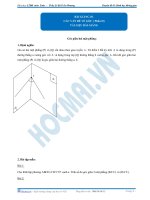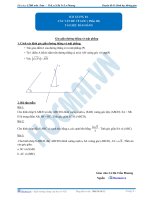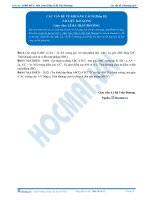Tài liệu Bài giảng 15c - Bảng câu hỏi CVM pdf
Bạn đang xem bản rút gọn của tài liệu. Xem và tải ngay bản đầy đủ của tài liệu tại đây (496.53 KB, 59 trang )
Bài giảng 15c: Bảng câu hỏi CVM
Trương Đăng Thụy
Typical Workplan for SP Study
Initial Research
Choice of survey method & valuation technique
Choice of population & sample
Questionnaire Design
Test the questionnaire & conduct main survey
Econometric Analysis
Validity & Reliability testing
Aggregation and reporting
What question is being answered?
What is the object being valued?
What is the survey method?
Contingent valuation or choice
modeling?
Database coded & transferred to
econometrics experts
Focus group
Re-design questionnaire
Pre-test survey
Re-design questionnaire
Conduct main survey
What form of question?
What elicitation format?
What payment vehicle?
What is the target population?
What kind of sample should be
selected?
Do the results meet validity & reliability
tests?
Aggregation to the target population &
reporting
Questionnaire Design
“. . .respondents give answers that
are inconsistent with the tenets
of rational choice, that these
respondents do not understand
what is it they are being asked
to value (and, thus, that stated
values reflect more than that
which they are being asked to
value), that respondents fail to
take CV questions seriously
because the result of the
surveys are not binding, and
raise other objections as well.”
!
An outstanding feature of the lower Mekong
region is the dynamic energy of its natural
systems.
The natural dynamics of the region is one of
its most important development assets to be
safeguarded and maintained. The essential
role of ecosystems in their natural state for
maintaining the stability and productivity of
local economies and social systems is
becoming increasingly evident in the Mekong
region. Around 80 per cent of its population
is directly dependent on the productive
capacity of healthy natural systems. The
relationship between water resources and
protected areas in particular is of growing
significance to the regional economy.
!
Governments of the region appear to have
recognized that the protection and
maintenance of its remaining natural
systems is essential to national welfare. The
natural systems which are the foundation for
regional development cross national
borders. Some of the most important
protected areas are adjacent to others in
neighboring countries.
Suppose a Regional Protected Area
Conservation Program would mean that you
and other households in Cambodia, Lao,
Thailand and Vietnam would pay a fixed
monthly fee of US$2 per month. The money
raised would go to the Lower Mekong
Region Protection Trust Fund.
!
Would you be willing to pay US$2/month for the
Regional Protected Area Conservation Program
for Lower Mekong protection?
___Yes ___No
If yes, why are you willing to pay?
If no, why are you not willing to pay?
(Pls. specify your one major reason)
Possible Problems
•
Individuals answer willingness-to-pay
questions inaccurately due:
–
To failure in understanding because the
questionnaire is poorly designed (vague or
insufficient vital information)
–
To problems with survey administration (e.g.
poorly trained enumerators)
"#$
%&#'(
)
Key element in SP: properly
designed questionnaire
)
Should make respondent
*
!+
*
,+
*
#,+
,
)
Principal Challenge: make scenario
understandable, plausible, &
meaningful
Stages of SP Questionnaire Design
Stages of SP Questionnaire Design
First stage: Formulating the valuation problem
-
Policy change being valued
-
Valuation scenario (Method of provision, Payment vehicle,
Decision rule, Time frame of payment)
-
Response Format
Second stage: Additional questions
- Debriefing & follow-up questions (screen protest & misleading
responses)
-
Attitudes, opinion, knowledge & uses
-
Demographics
-
Questionnaire structure
Third stage: Pre-testing the questionnaire
- Focus groups, re-design questionnaire, pre-test, re-design again
-
.
+.,
+.,
)
Description of the changes in
resource/service conditions due to
the policy change being valued.
)
Essentials:
*
+
/
*
#/
0
*
.
.1
/+
)
Scientific uncertainty about the
physical effects;
)
Unclear how physical changes affect
well-being;
)
It may be difficult to get those in
charge of a policy or project that will
lead to the change to be valued to
commit to what the project will
actually do;
)
Difficult to convey the effects of
policy change;
/.1
/+
Change to
be valued
Problems
Damages
caused in a
river from
increased
water
abstraction
- Scientific uncertainty regarding physical
changes caused by abstractions.
- Difficulty in describing wide range of changes
in flora, fauna, etc.
- Damages may be different in different
stretches of the river.
+,00
0
)
Physical descriptions of changes
in resource conditions frequently
are not available.
)
Contingent valuation questions
often are framed to value the
policy change.
*
/.000
)
/ !
/
/+ /0
)
"2/
2/300+
,20
/
•What is the policy change being
valued?
Expansion and conservation of Protected Areas
in the Lower Mekong Region
•What is the change in resource
condition being addressed by the
policy being valued?
Improved drinking water supply function of
Mekong River system. . .expand coverage from
60% to 90% of all households
4%+5
.,6.+5/7
)
What is the policy change?
)
What is/are the change/s in
resource/service condition that
will be affected by policy
change?
-
.
-
-
/
)
Values are contingent on various
aspects of the scenario presented &
questions asked
)
/,.
)
)
+/,8
)
)
/+
-0".+
a. Description of the attributes of the
good under investigation in a way that
is meaningful and understandable to
respondents.
*
"./
,..
*
-!..
,
,
*
.
/1
-0".+
b. Description of the proposed policy
change.
)
)
/
)
"
)
/
)
)
5/
-40".
!
a. Institution
b. Technical and political feasibility of
the change
c. Conditions for provision of the good
)
#/9/,
/+.
/9/
./,
d. Who will have to pay and who will
benefit or lose from it
-:0".
+
a. Choice of benefit measure
b. Payment Vehicle
c. Individual or household payment
Note: Reference income to be elicited in the
survey should be consistent with the unit of
analysis
d. Timing of payment
;
&/6;</7=
++3+3+3/,
6+/,7
;
8+2
+. /+>???
!/@/,,
8+...+
,A
,
+. /+>???
!/@,,
8+...+
A
+. /
>???!/@/
, 8+.
..+A
+. /
>???!/@
/,,
8+...+
,A
-:0+
B1
)
Should be perceived by the
respondent to be linked directly
to the provision of the good.
)
If mandatory, once a
commitment has been made,
respondents take the notion of
payment seriously (NOAA
Recomm).
-:0+
+









